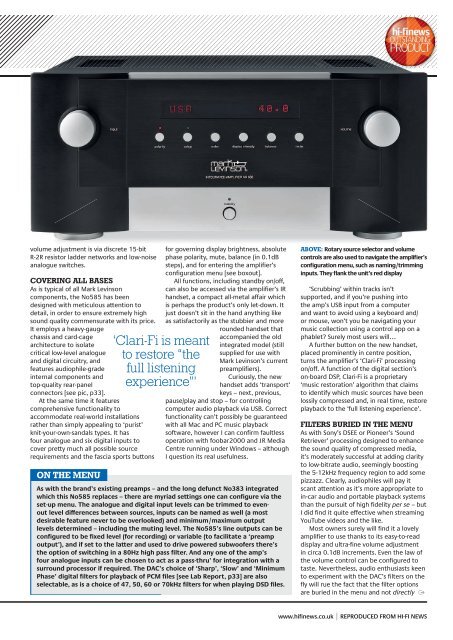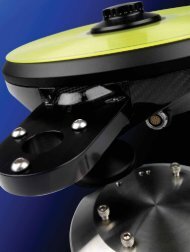HiFiNews,April15_MLNo585
HiFiNews,April15_MLNo585
HiFiNews,April15_MLNo585
You also want an ePaper? Increase the reach of your titles
YUMPU automatically turns print PDFs into web optimized ePapers that Google loves.
volume adjustment is via discrete 15-bit<br />
R-2R resistor ladder networks and low-noise<br />
analogue switches.<br />
COVERING ALL BASES<br />
As is typical of all Mark Levinson<br />
components, the No585 has been<br />
designed with meticulous attention to<br />
detail, in order to ensure extremely high<br />
sound quality commensurate with its price.<br />
It employs a heavy-gauge<br />
chassis and card-cage<br />
architecture to isolate<br />
critical low-level analogue<br />
and digital circuitry, and<br />
features audiophile-grade<br />
internal components and<br />
top-quality rear-panel<br />
connectors [see pic, p33].<br />
At the same time it features<br />
comprehensive functionality to<br />
accommodate real-world installations<br />
rather than simply appealing to ‘purist’<br />
knit-your-own-sandals types. It has<br />
four analogue and six digital inputs to<br />
cover pretty much all possible source<br />
requirements and the fascia sports buttons<br />
ON THE MENU<br />
‘Clari-Fi is meant<br />
to restore “the<br />
full listening<br />
experience”’<br />
for governing display brightness, absolute<br />
phase polarity, mute, balance (in 0.1dB<br />
steps), and for entering the amplifier’s<br />
configuration menu [see boxout].<br />
All functions, including standby on/off,<br />
can also be accessed via the amplifier’s IR<br />
handset, a compact all-metal affair which<br />
is perhaps the product’s only let-down. It<br />
just doesn’t sit in the hand anything like<br />
as satisfactorily as the stubbier and more<br />
rounded handset that<br />
accompanied the old<br />
integrated model (still<br />
supplied for use with<br />
Mark Levinson’s current<br />
preamplifiers).<br />
Curiously, the new<br />
handset adds ‘transport’<br />
keys – next, previous,<br />
pause/play and stop – for controlling<br />
computer audio playback via USB. Correct<br />
functionality can’t possibly be guaranteed<br />
with all Mac and PC music playback<br />
software, however I can confirm faultless<br />
operation with foobar2000 and JR Media<br />
Centre running under Windows – although<br />
I question its real usefulness.<br />
As with the brand’s existing preamps – and the long defunct No383 integrated<br />
which this No585 replaces – there are myriad settings one can configure via the<br />
set-up menu. The analogue and digital input levels can be trimmed to evenout<br />
level differences between sources, inputs can be named as well (a most<br />
desirable feature never to be overlooked) and minimum/maximum output<br />
levels determined – including the muting level. The No585’s line outputs can be<br />
configured to be fixed level (for recording) or variable (to facilitate a ‘preamp<br />
output’), and if set to the latter and used to drive powered subwoofers there’s<br />
the option of switching in a 80Hz high pass filter. And any one of the amp’s<br />
four analogue inputs can be chosen to act as a pass-thru’ for integration with a<br />
surround processor if required. The DAC’s choice of ‘Sharp’, ‘Slow’ and ‘Minimum<br />
Phase’ digital filters for playback of PCM files [see Lab Report, p33] are also<br />
selectable, as is a choice of 47, 50, 60 or 70kHz filters for when playing DSD files.<br />
ABOVE: Rotary source selector and volume<br />
controls are also used to navigate the amplifier’s<br />
configuration menu, such as naming/trimming<br />
inputs. They flank the unit’s red display<br />
‘Scrubbing’ within tracks isn’t<br />
supported, and if you’re pushing into<br />
the amp’s USB input from a computer<br />
and want to avoid using a keyboard and/<br />
or mouse, won’t you be navigating your<br />
music collection using a control app on a<br />
phablet? Surely most users will…<br />
A further button on the new handset,<br />
placed prominently in centre position,<br />
turns the amplifier’s ‘Clari-Fi’ processing<br />
on/off. A function of the digital section’s<br />
on-board DSP, Clari-Fi is a proprietary<br />
‘music restoration’ algorithm that claims<br />
to identify which music sources have been<br />
lossily compressed and, in real time, restore<br />
playback to the ‘full listening experience’.<br />
FILTERS BURIED IN THE MENU<br />
As with Sony’s DSEE or Pioneer’s ‘Sound<br />
Retriever’ processing designed to enhance<br />
the sound quality of compressed media,<br />
it’s moderately successful at adding clarity<br />
to low-bitrate audio, seemingly boosting<br />
the 5-12kHz frequency region to add some<br />
pizzazz. Clearly, audiophiles will pay it<br />
scant attention as it’s more appropriate to<br />
in-car audio and portable playback systems<br />
than the pursuit of high fidelity per se – but<br />
I did find it quite effective when streaming<br />
YouTube videos and the like.<br />
Most owners surely will find it a lovely<br />
amplifier to use thanks to its easy-to-read<br />
display and ultra-fine volume adjustment<br />
in circa 0.1dB increments. Even the law of<br />
the volume control can be configured to<br />
taste. Nevertheless, audio enthusiasts keen<br />
to experiment with the DAC’s filters on the<br />
fly will rue the fact that the filter options<br />
are buried in the menu and not directly<br />
www.hifinews.co.uk | REPRODUCED FROM HI-FI NEWS



